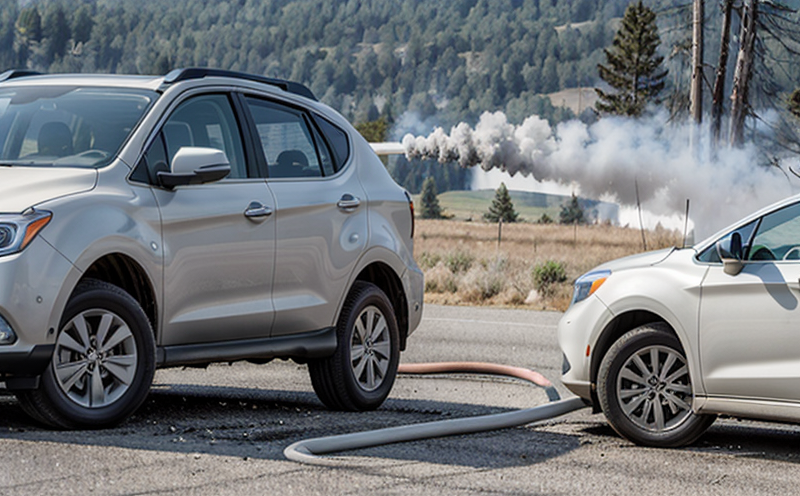ASTM E1354 Cone Calorimeter Smoke Analysis
The ASTM E1354 Cone Calorimeter Smoke Analysis is a critical test used to evaluate the smoke production and toxic gas emissions of materials under fire exposure. This method is particularly important for ensuring that building materials, furnishings, and other combustibles meet stringent safety standards in various sectors including construction, architecture, and interior design.
The test involves placing a specimen on a cone calorimeter apparatus, which simulates the conditions of an actual fire by subjecting it to controlled radiant heat flux. The apparatus measures both the smoke production rate (SPR) and the total heat release rate (THR). These parameters are key indicators of a material's potential to contribute to or mitigate a fire situation.
The ASTM E1354 Cone Calorimeter provides valuable data that helps in assessing the flammability and toxicity of materials. This information is essential for compliance with regulations such as ISO 834, EN 13960, and NFPA standards, which mandate that certain materials must pass these tests to be used safely in public buildings.
The test procedure involves several steps: first, the specimen is prepared according to specific dimensions. The calorimeter is then set up with a radiant heat source and an oxygen concentration sensor. The specimen is exposed to the heat flux for a predetermined time period, during which the apparatus records the SPR and THR values. After the exposure, the specimen is removed from the calorimeter, and post-test analysis may be conducted to ensure no residual effects.
The accuracy of these tests is paramount in ensuring that materials are not only safe but also meet the necessary performance criteria. Compliance with ASTM E1354 ensures that manufacturers and designers can confidently use tested materials in their products or projects knowing they have been rigorously evaluated for fire safety.
Understanding the real-world implications, this test plays a crucial role in minimizing the risk of fires by providing insights into how materials behave under controlled fire conditions. This information is invaluable for R&D engineers and quality managers who need to ensure that their products meet or exceed industry standards.
Scope and Methodology
| Parameter | Description |
|---|---|
| Radiant Heat Flux | The intensity of heat that the specimen is exposed to during testing, typically ranging from 50 kW/m2 to 100 kW/m2. |
| Oxygen Concentration | The percentage of oxygen in the combustion chamber, which affects the heat release and smoke production. |
| Specimen Dimensions | The size and shape of the specimen used for testing, ensuring consistency across tests. |
In this test, a specimen is placed on an inclined cone that directs radiant heat onto its surface. The apparatus records the temperature rise in the specimen as well as the amount of smoke produced over time. The total heat release rate (THR) and the smoke production rate (SPR) are calculated from the data collected during the exposure period.
The ASTM E1354 Cone Calorimeter provides a standardized approach to measuring these parameters, ensuring that results can be compared reliably across different materials or products. This standardization is crucial for consistency in testing and compliance with international standards.
Benefits
The benefits of conducting ASTM E1354 Cone Calorimeter Smoke Analysis extend beyond mere compliance; they offer significant advantages that enhance safety, reliability, and performance. By evaluating the smoke production and toxic gas emissions of materials under fire exposure, this test ensures that products are not only safe but also contribute positively to fire safety.
One of the primary benefits is enhanced safety for occupants in buildings where these materials are used. The data provided by this test can help identify materials that may produce excessive smoke or toxic gases during a fire, enabling manufacturers and designers to make informed decisions about material selection.
The test also aids in compliance with various regulations and standards such as ISO 834, EN 13960, and NFPA codes. By ensuring that products meet these requirements, manufacturers can avoid legal issues and maintain a positive reputation in the market. This is especially important for companies operating in regulated industries where safety is paramount.
Additionally, ASTM E1354 Cone Calorimeter Smoke Analysis supports research and development efforts by providing detailed insights into how materials behave under fire conditions. Engineers and researchers can use this information to innovate and improve product designs, leading to safer and more effective solutions.
The test also benefits procurement departments by providing objective data that can be used to select the best materials for specific projects or applications. This ensures that the chosen materials meet the necessary performance criteria and contribute positively to fire safety.
Industry Applications
| Industry | Description |
|---|---|
| Construction Industry | The construction industry benefits significantly from ASTM E1354 Cone Calorimeter Smoke Analysis as it helps ensure that building materials comply with fire safety regulations. This ensures the safety of occupants in case of a fire. |
| Furnishings and Interior Design | This test is crucial for ensuring that furnishings and interior design elements meet fire safety standards, contributing to safer living environments. |
| Manufacturing | In the manufacturing sector, this test helps identify materials that can be used in products without compromising on fire safety. This ensures that the final product meets all necessary requirements. |
The ASTM E1354 Cone Calorimeter Smoke Analysis has broad applications across various industries where fire safety is a critical concern. In construction, it helps ensure compliance with regulations and provides valuable insights into material behavior during fires. For furnishings and interior design, this test ensures that products meet stringent safety standards, contributing to safer living environments. In manufacturing, the test supports R&D efforts by providing detailed data on material performance under fire conditions.
The results of these tests are used in various sectors to improve product design and ensure compliance with industry standards. By using materials that have passed this rigorous testing, companies can enhance their reputation for quality and safety, leading to increased customer trust and satisfaction.





